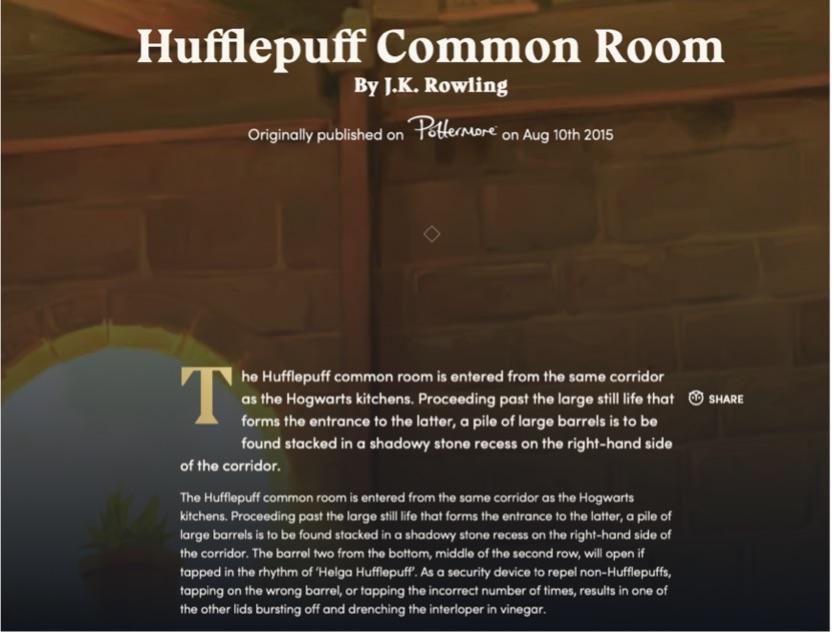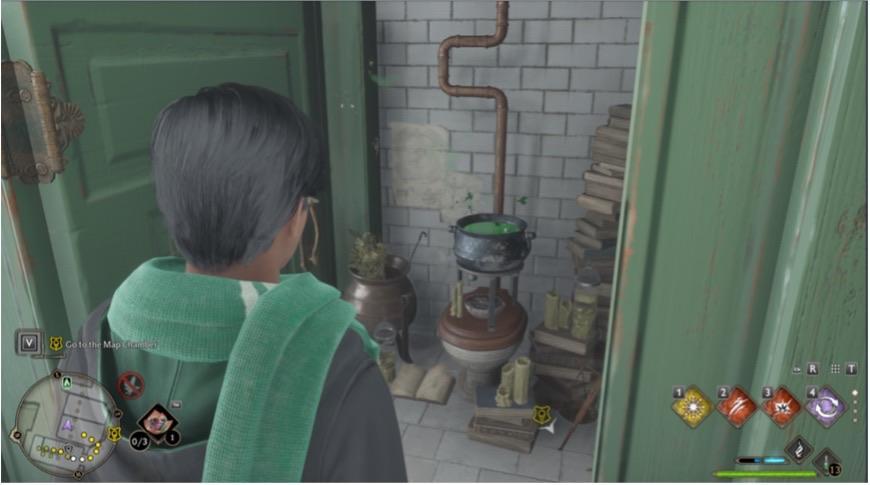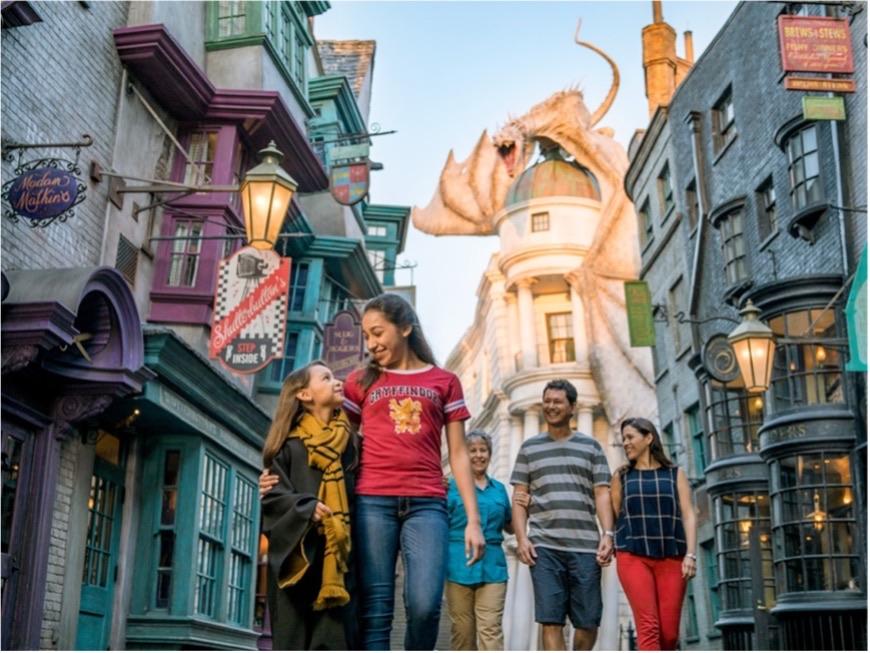
Transmedia and Convergence: World-Building in the Wizarding World of Harry Potter
The Harry Potter franchise is magical in its own way. Since the release of the first book in the series – ‘Harry Potter and the Philosophers’ Stone’ in 1997 – the enchanting stories created by J.K. Rowling spread around the world. The books are bestsellers, popular among children as well as adults. Rowling’s Harry Potter series was not limited to just books, since 8 Harry Potter movie adaptations were released the years after. It does not even stop there; next to movies, the story world of Harry Potter – also known as the Wizarding World (or WW) – is extended over various media, making it a transmedia experience. This paper will dive into the WW, with reference to theoretical principles like transmedia and cultural convergence as described by Henry Jenkins.
It all starts in 1997 with the release of the first Harry Potter book in the series. It is safe to say that the writer, J.K. Rowling, did not see the book’s explosive popularity coming since this was the first book she had ever released. The book sold millions of copies since it was released making it her first bestseller. However, this is not to praise J.K. Rowling as she has made problematic comments in the past, after which the cast of the Harry Potter movies even spoke out against her (Gardner, 2023). Therefore, this is a classic case of separating the art from the artist. After the success of the first book, numerous books and movies followed. Later on, other types of media were added to the WW. This is where the WW enters the transmedia scope. Firstly, it is crucial to understand what transmedia is and how this relates to the WW.
Transmedia represents a process where integral elements of a fiction get dispersed systematically across multiple delivery channels for the purpose of creating a unified and coordinated entertainment experience
Transmedia World-Building of the Wizarding World
In 2007, Henry Jenkins published a blog post called ‘Transmedia Storytelling 101’. He initially describes transmedia as representing “a process where integral elements of a fiction get dispersed systematically across multiple delivery channels for the purpose of creating a unified and coordinated entertainment experience.” (Jenkins, 2007). In short, in transmedia, a story or a narrative is told across different types of media where the consumer must put the pieces of the puzzle together. Each medium provides a different part of the story and when taken together, the full picture is complete. Therefore, the different types of media are complementary to each other, more on that later. Some examples of transmedia storytelling are Star Wars, Game of Thrones, and the stories from the Marvel Cinematic Universe.
It is important to distinguish between transmedia, multimedia, and cross-platform. There can be overlap between them but there are also distinct differences. Henry Jenkins highlighted these differences in another blog post called ‘Transmedia What?’ (2016). Cross-platform could for example be the distribution of a movie via different media channels like Netflix or DVDs. When an app or a website includes different types of media like text, video, and audio, it is multimedia. While transmedia can deploy multimedia and cross-platform tactics, other elements are present as well. Transmedia is multimodal, intertextual, and dispersed. This means that transmedia deploys the affordances of more than one medium, with each medium offering unique content and it is spread over various media for the viewer to construct an understanding of the core ideas (Jenkins, 2016).
In the case of the WW, transmedia storytelling goes across several types of media providing an immersive world to interact with. Ryan (2013) argued that what is known as the story world is central to transmedia storytelling. She notes that “The ability to create a world, or more precisely, to inspire the mental representations of a world, is the primary condition for a text to be considered a narrative” (p. 363-364). In the WW, this starts with the books and the movies, since this is where the basis of the story is set, and most people will dip into that story first before diving into the extended WW. The website ‘Pottermore’ was a turning point in the transmedia narrative of the WW. It was released in 2011 right after the final Harry Potter movie came out. ‘Pottermore’ was described by Cuntz-Leng (2013) as “the newest manifestation of the continuous transformation process of the Harry Potter universe in order to keep it adjusted to the needs and expectations of the participatory culture and the so-called digital generation” (p. 68). Since the website’s release in 2011, it has been rebranded as ‘Wizarding World’. Users can find out into what house they would be sorted, what magic wand they would get, and what their Patronus is. The website features the J.K. Rowling archive, which is a collection of writings that contain information about the WW. It, therefore, functions as an encyclopedia. For example, information about the Hufflepuff Common Room was posted on the website (Fig. 1).

Figure 1. Information on the Hufflepuff Common Room on ‘Wizarding World’
This makes the WW somewhat more immersive, and the website pulls people into the story world. The information that is added to the website does world-building beyond the books and the movies. The participatory culture of the Harry Potter fandom happens outside of ‘Wizarding World’. Fanfictions and other fan-generated content are widespread on other online sources.
Cultural Convergence and Participatory Fan Culture
Another important term described by Henry Jenkins is ‘convergence’, which he wrote about in his book ‘Convergence Culture’ (2006). Convergence is “the flow of content across multiple media platforms, the cooperation between multiple media industries, and the migratory behavior of media audiences who will go almost anywhere in search of the kinds of entertainment experiences they want” (Jenkins, 2006, p. 2). There are 5 types of media convergence of which ‘cultural convergence’ is most applicable to the WW. One aspect of cultural convergence is participatory culture, which is the blending of cultural forms through media by reinterpreting/remixing already existing media content (Understanding Media and Culture, 2006). Moreover, convergence is understood as both a top-down corporate-driven process, and a bottom-up consumer-driven process (Jenkins & Deuze, 2008). When this is applied to the WW, the top-down corporate-driven process would be for example the release of the website ‘Wizarding World’. By releasing varying types of media, companies are able to accelerate the flow of media content across different channels, thereby increasing revenue opportunities and reinforcing consumer loyalty (Jenkins & Deuze, 2008).
Convergence and transmedia often go hand in hand since convergence enables the circulation of content that adds to the transmedia narrative. Therefore, cultural convergence allows the passive consumption of media to change into a participatory culture. This is the bottom-up consumer-driven process of convergence culture. In the Harry Potter fandom, there seem to be endless pages of fan fiction about the WW. Fan fiction emerges frequently when a distinct world is in place for people to apply their imagination to. It is through this world-building that a narrative universe is created. Schiller (2018) notes that “these stories manifest themselves less as singular plots, and may seem to readers and viewers more like architecturally narrative universes, inhabited by multiple characters, and articulating complex temporalities and contradictory perspectives” (p. 102). In doing so, the WW leaves much room to play for fans and as a result, the WW can be expanded or altered endlessly through fan fiction to fit the fans’ needs. Kustritz (2014) argued that “the boundaries and components of corporate transmedia narratives most often result from a combination between money and power, making fan works a grassroots alternative that places emphasis on the audience’s preferences, contributions, and control” (p. 226). One example is the #BlackHermione fan fiction, in which one of the main characters of Harry Potter is a person of color as opposed to the movies in which she is white. This was incorporated into the Harry Potter universe as the adult version of the character was portrayed by Noma Dumezweni – a black actress – in the stage production of ‘Harry Potter and the Cursed Child’ in 2016 (Schiller, 2018).
Hogwarts Legacy
The most recent addition to the WW is the game Hogwarts Legacy. It was not the first Harry Potter game that was released, since several games preceded the release of the open-world action RPG. As discussed earlier, the WW relies on world-building, and Hogwarts Legacy takes full advantage of this. The game is open-world, meaning that players can do whatever they want. There is a certain storyline attached but players get a lot of freedom to move wherever they want, whenever they want to. By creating a game where the WW is open, players have the ability to interact with the world, making it an almost real experience. As with the other Harry Potter games, Hogwarts Legacy adds to the transmedial WW as well, since many easter eggs can be found referring to Harry Potter lore. For example, in one of the girl’s bathrooms in the game players can find a brewing ‘Polyjuice Potion’ (Fig. 2), which is a reference to Harry Potter and the Chamber of Secrets when Hermione brews that potion (IGN, 2023).

Figure 2. ‘Polyjuice Potion’ in the girls’ bathroom of ‘Hogwarts Legacy’
The Wizarding World in Real Life
Transmedia storytelling can also be deployed in real-life settings. The game Hogwarts Legacy already allows people to interact with the WW freely in an immersive environment, but this is inside a game. In gaming, there is always a certain degree of “fakeness” since it is played from the comfort of your own home. However, diving into the WW in real life is also possible in the Universal Studios theme park in Orlando. People can visit locations that resemble those of the Harry Potter world like ‘Hogsmeade’ and ‘Diagon Alley’(Fig. 3). In that sense the transmedia narrative of the WW is pulled out of fiction and thrust into real life. For example, theme parks have rides that take visitors on an adventure through Hogwarts Castle. Furthermore, just like on the Wizarding World website, visitors can practice spellcasting and choose a wand. This offers an experience that is only possible through transmedia storytelling and world-building because engagement is built with it and people want to be part of the story that is created.

Figure 3. ‘Diagon Alley’ at Universal Studios Orlando theme park
The Power of Transmedia Storytelling
This paper elaborated on the Wizarding World of Harry Potter and how transmedia approaches are deployed through several media channels. Henry Jenkins wrote about the power of transmedia storytelling and convergence culture years ago and these concepts are increasingly gaining popularity in the digital age. Technology and the emergence of the internet opened doors for endless opportunities to tell stories in ways that would have been unimaginable in the past. The WW plays into these affordances making it one of the most successful franchises in recent decades. This happens through top-down corporate-driven processes, via websites extending the story, games, and theme parks. Moreover, fans play a big role in this since bottom-up consumer-driven processes like fan fiction are central bricks to the WW. As argued by Schiller (2018), fans are becoming active “agents in the creation and negotiation of the meaning-making of (popular) cultural texts” (p. 103). This creates a shift in the meaning of authorship and changes how media industries function as a whole. As the story world is set in place, endless reiterations of stories in the WW are possible, and convergence culture and transmedia are the basis of this. Therefore, Jenkins did not underestimate the power of transmedia storytelling and it is exciting to see what the future will bring and what other stories will be told through these channels.
References
Cooper, L. (2023). ‘Diagon Alley’ at Universal Studios Orlando theme park [Photograph]. Discover Universal.
Cuntz-Leng, V. (2013). Potterless: Pottermore and the Pitfalls of Transmedia Storytelling. In Bowman, S.L., & Vanek, A. (Ed.), Wyrd Con Companion Book 2013 (pp. 68-76). Wyrdcon LLC.
Gardner, A. (2023, April 25). A Complete Breakdown of the J.K. Rowling Transgender-Comments Controversy. Glamour.
IGN. (2023, February 21). Easter Eggs and Secrets. IGN.
Jenkins, H. (2006). Convergence Culture: Where Old and New Nedia Collide. New York University Press.
Jenkins, H. (2007, March 21). Transmedia Storytelling 101. Henry Jenkins.
Jenkins, H., & Deuze, M. (2008). Editorial: Convergence Culture. Convergence, 14(1), 5–12.
Jenkins, H. (2016, November 15). Transmedia What? Immerse.
Kustritz, A. (2014). Seriality and Transmediality in the Fan Multiverse: Flexible and Multiple Narrative Structures in Fan Fiction, Art, and Vids. TV/Series, (6).
Rowling, J.K. (2015, August 10). Hufflepuff Common Room [Screenshot]. Wizarding World.
Ryan, M. -L. (2013). Transmedial Storytelling and Transfictionality. Poetics Today: International Journal for Theory and Analysis of Literature and Communication, 34(3), 361–388.
Schiller, M. (2018). Transmedia Storytelling. Stories. Screen Narrative in the Digital Age, 97-108.
Understanding Media and Culture. (2016). University of Minnesota Libraries.